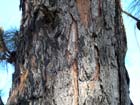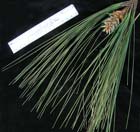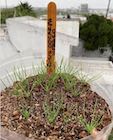Pinus oocarpa
Schiede ex Schlectendahl 1838
Common names
Pino de colorado, pino de ocote, pino prieto, pino amarillo [Spanish].
Taxonomic notes
Pinus tecunumanii was formerly placed in synonymy, but is now regarded as a distinct species (Farjon and Styles 1997), as is P. luzmariae, formerly treated as P. oocarpa var. trifoliata. Other closely-related species are all Mexican members of Pinus subsection Australes. An analysis examining both nuclear and cytoplasmic DNA markers consistently placed P. oocarpa sister to P. pringlei in a clade that also included P. jaliscana, P. lawsonii, and P. praetermissa, though the relationships within the clade differed somewhat between the nuclear and cytoplasmic trees (Gernandt et al. 2018).
Type: Mexico, Michoacan, Aguililla, Las Playitas Foreest Station, B.T. Styles 36. Synonyms: Pinus oocarpoides Lindl. ex Loudon 1842, Pinus oocarpa var. oocarpoides (Lindl. ex Loudon) Endlicher 1847; Pinus oocarpa var. manzanoi Martínez 1940 (Farjon 1998).
Description
Trees to 35 m tall and 130 cm dbh, usually with a single erect trunk and long, spreading branches forming a rounded or irregular crown. Bark on mature trees thick, rough, and scaly, breaking into small or large, longitudinal plates and shallow fissures, brown fading toward gray. Twigs rough and scaly, reddish brown. Cataphylls 10-15 mm long, subulate, recurved, scarious, brown, weathering blackish grey. Vegetative buds ovoid-oblong to fusiform; terminal bud 15-25 mm long; not resinous. Fascicle sheaths up to 25 mm long, persistent, not reduced in length, red-brown weathering to nearly black. Leaves in fascicles of 4-5, persisting 2-3 years, straight, rigid or less commonly pliant, (11-)14-25(-30) cm long, 0.8-1.6 mm thick, acute-pungent, lustrous yellowish green, with stomata on all faces. Pollen cones oblong-cylindrical, 15-20 × 5-6 mm, pink or reddish when ripe. Seed cones subterminal, solitary or in whorls of 2-4 on stout, up to 35 mm long, recurved peduncles which eventually fall with the cones, persisting for several years after seed dispersal. Mature cones ovoid to globose, semi-serotinous, when opened often wider than long, with a flattened base, 3-8(-10) cm long. Seed scales thick woody, symmetrical, oblong, straight or slightly recurved. Apophysis nearly flat or slightly raised, in some cones pyramidal, weakly transversely keeled, rhombic to pentagonal, lustrous, reddish to light brown, weathering grey. Umbo dorsal, flat or raised, sometimes curved, obtuse or rarely with a minute prickle. Seeds obliquely ovoid, slightly flattened, 4-8 mm long, dark gray, often with black spots. Seed wings 8-18 mm long, pale brown (Farjon 2010).
Distribution and Ecology
Mexico: Sonora, Sinaloa, Durango, Nayarit, Zacatecas, Jalisco, Michoacán, México, Distrito Federal, Hidalgo, Puebla, Morelos, Tlaxcala, Guerrero, Oaxaca, Veracruz and Chiapas; Guatemala; Honduras; El Salvador; and Nicaragua. See also Thompson et al. (1999). Trees formerly reported from Belize (Critchfield and Little 1966, Perry 1991) are now assigned to P. tecunumanii (Farjon and Styles 1997).
Distribution data from USGS (1999). Points plotted as tree icons represent isolated or approximate locations.
Across its wide range, P. oocarpa varies widely in climate and ecological settings. It occurs at elevations of 200-2700 m, with precipitation of 700-3000 mm/year, though mostly with an October-June dry season. As with most pines, fire is an important environmental variate, but human activities have greatly altered the frequency and severity of fires. This species usually occurs in open woodland or forest, in pure stands or within a pine-oak woodland. Commonly associated pines include P. engelmannii, P. leiophylla, and P. douglasiana in the northwest of its range; and P. maximinoi, P. devoniana, and P. tecunumanii farther southeast. In areas that haven't burned for some time, a shrub understory develops, with species of (e.g.) Calliandra, Acacia, Leucaena, Hybosema, Byrsonima, and Leucothoe (Farjon 2010).
Humans have greatly increased the frequency of fires within this species' range; this poses a serious threat to the development and persistence of mature pine stands. In Mesoamerica, both fires and infestations by the pine beetle Dendroctonus mexicanus are frequently followed by "salvage" operations that convert the forest to pasture (Perry 1991). However, the species remains widespread and numerous, resulting in a "least concern" conservation status.
Hardy to Zone 9 (cold hardiness limit between -6.6°C and -1.1°C) (Bannister and Neuner 2001).
Remarkable Specimens
Ethnobotany
Currently, this is an important timber tree, extensively used for general carpentry, beams, poles, and railway ties. It is also widely tapped for resin, but only for a few years before felling. Besides its importance in Mexico and Central America, P. oocarpa is used for agroforestry in many subtropical and tropical countries, especially in West Africa, South Africa, and in Brazil, Colombia and Argentina. Conversely, it is rarely encountered in horticulture (Farjon 2010).
Observations
In El Salvador, it occurs with Pinus maximinoi on Cerro el Pital in La Palma town and above, at 900-1500 m elevation. While you're there, from 1500-2500 m the forest is mixed with Pinus tecunumanii and Pinus pseudostrobus var. apulcensis, and above 2000 m it is easy to find pure and mixed forests of Pinus ayacahuite (Fernando Tobar email 2008.11.12).
Also in El Salvador, on Cerro Montecristo, there natural forests of Pinus oocarpa on the lowest peaks, again mixed with Pinus maximinoi. On the highest peaks you can find Pinus pseudostrobus var. pseudostrobus with Pinus tecunumanii. Also, on the highest part of the mountain in Quercus-dominated cloud forests, is the only place in El Salvador where Podocarpus oleifolius grows in the wild (Fernando Tobar email 2008.11.12).
Remarks
The epithet combines the Greek roots for egg (oos) and fruit (carpos), in reference to the shape of the seed cones.
This species is a principal host for the dwarf mistletoe Arceuthobium aureum subsp. petersonii in Oaxaca and Chiapas, and is the sole host of A. hondurense in Honduras (Hawksworth and Wiens 1996).
Citations
Conifer Specialist Group. 1998. Pinus luzmariae. https://www.iucnredlist.org (accessed 2006.11.21).
Farjon, Aljos. 2010. A Handbook of the World's Conifers. Leiden, Netherlands: Brill Academic Publishers.
Farjon, A., and B.T. Styles. 1997. Pinus (Pinaceae). Flora Neotropica Monograph 75. New York, NY: The New York Botanical Garden.
Gernandt, D. S., X. Aguirre Dugua, A. Vázquez-Lobo, A. Willyard, A. Moreno Letelier, J. A. Pérez de la Rosa, D. Piñero, and A. Liston. 2018. Multi-locus phylogenetics, lineage sorting, and reticulation in Pinus subsection Australes. American Journal of Botany 105(4):711–725.
Perry, Jesse P. 1991. The pines of Mexico and Central America. Portland, OR: Timber Press.
Schlechtendahl, D.F.L. von. 1838. Vorlaufige Nachricht uber die Mexicanischen Coniferen. Linnea: ein Journal für die Botanik in ihrem ganzen Unfange 12:486-496. Available: www.botanicus.org, accessed 2011.03.20.
See also
Cordero, J. and D.H. Boshier (eds.). 2004. Pinus oocarpa Schiede ex Schltdl. Pp. 767-770 in Árboles de Centroamérica. UK: Oxford Forestry Institute (OFI) and Costa Rica: Centro Agronómico Tropical de Investigación y Enseñanza (CATIE). herbaria.plants.ox.ac.uk/adc/downloads/capitulos_especies_y_anexos/pinus_oocarpa.pdf [in Spanish], accessed 2011.02.25.
Dvorak, W.S., E.A. Gutiérrez, L.F. Osorio, G.R. Hodge, and J.T. Brawner. 2000. Pinus oocarpa. Pp. 128-147 in Conservation & Testing of Tropical & Subtropical Forest Tree Species by the CAMCORE Cooperative. Raleigh, NC: College of Natural Resources, NCSU.
Dvorak, W.S. 2003. Pinus oocarpa. Species description in the Tropical Tree Seed Manual. Available http://www.rngr.net/Publications/ttsm/Folder.2003-07-11.4726 (accessed 2007.08.31).








